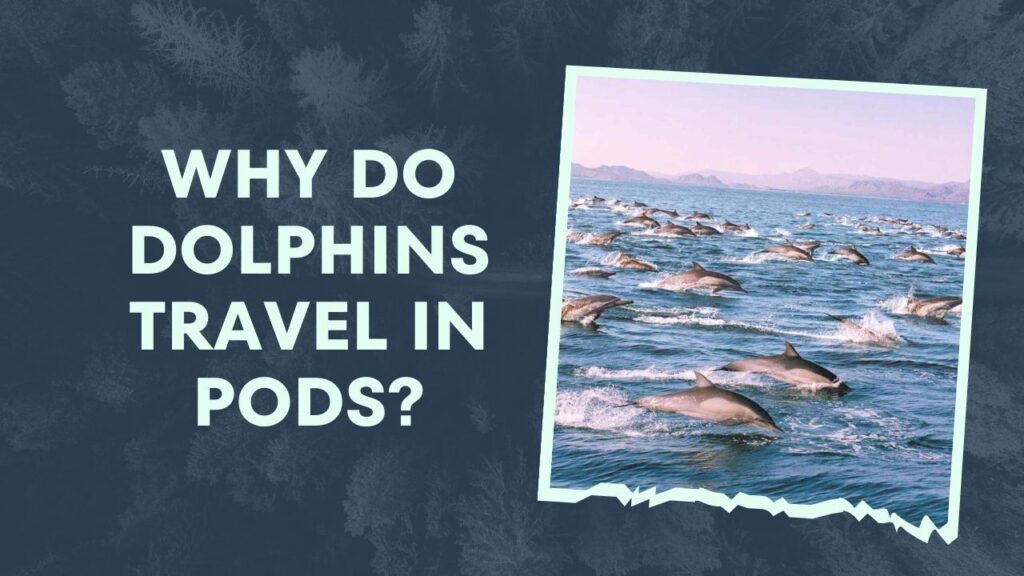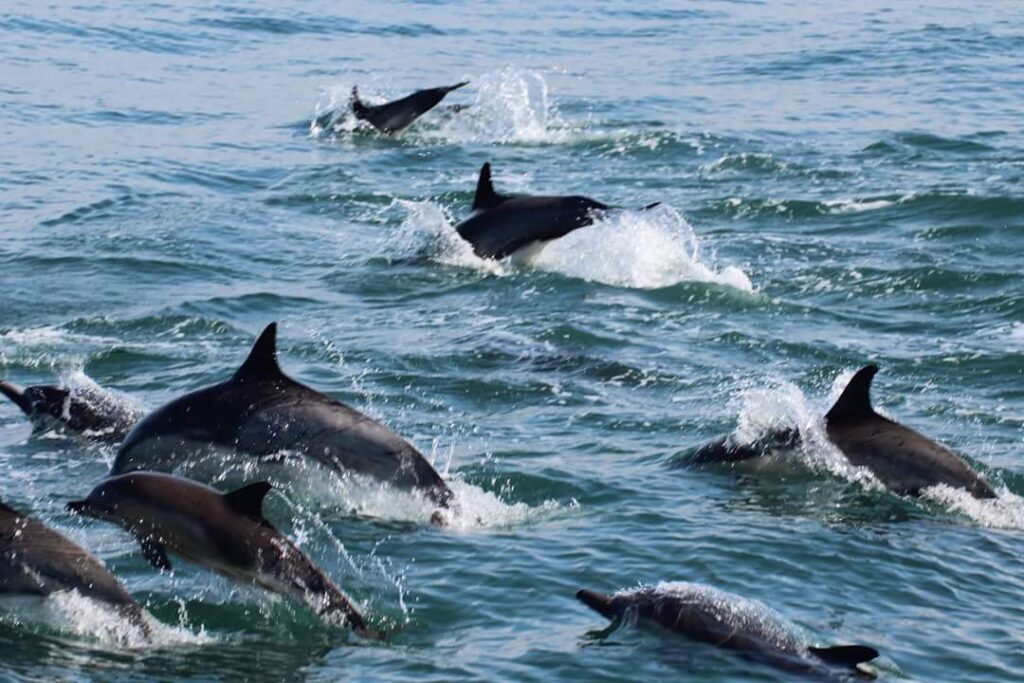Last updated on December 28th, 2023 at 04:05 pm

Why Do Dolphins Travel In Pods? Dolphins travel in pods as a means of protection and social interaction1. Pod travel allows them to defend themselves against predators and navigate the ocean more effectively.
It also helps them hunt, interact, and raise their young in a coordinated and orderly fashion, which increases their chances of surviving in the varied and frequently unpredictably changing ocean.
Their mental and emotional health is greatly aided by the strong social ties that exist within the pods, which also give them a sense of belonging.
Dolphins can exchange information, experiences, and resources when they move in pods, which enhances their general well-being and capacity for adaptation.
Pod travel is an integral part of the everyday lives of these amazing marine creatures, whose intelligence and social complexity are reflected in their collective activities.
Table of Contents
Evolutionary Background Of Dolphin Pods
Dolphins’ amazing social behavior is the result of a lengthy and intricate evolutionary history.
According to research, dolphins’ tendency to form pods can be linked to their early ancestors, who sought protection and safety in numbers.
These extremely clever animals have evolved complex social structures and cooperative activities over millions of years2, resulting in the creation of close-knit pods.
See Also: Can A Dolphin Live Alone? How Long Can A Dolphin Live Alone?
Impact Of Environmental Factors On Pod Formation
Dolphin pod dynamics and formation are heavily influenced by environmental conditions, including the presence of predators, water temperature, and food supplies.
Pods tend to be smaller and more specialized in locations with limited resources, but they can also be bigger and more varied in places where food is plentiful.
Strong social ties inside pods have also evolved as a result of the existence of natural predators, as collaboration and interaction are essential for survival in these settings. [Why Do Dolphins Travel In Pods?]
Reasons For Pod Formation
Dolphins migrate in pods for a variety of purposes, such as social engagement, food search, and predator protection.
Pods provide safety in numbers, which facilitates cooperative hunting and threat defense.
In addition, it gives the dolphins chances to socialize and communicate with one another, which improves their survival and general well-being in the water.
Causes of Pod Formation Dolphins are renowned for being gregarious animals that frequently travel in pods, exhibiting a strong sense of camaraderie and teamwork.
An essential component of their social activity and survival is the development of these pods. Now let’s explore the rationale for dolphins’ pod travel.
See Also: How Do Dolphins Live Together? How Many Dolphins Live Together?
Social Cohesion And Cooperation Within The Pod
Dolphins group together in pods to promote cooperation and social bonding among their fellow members.
They are dependent on one another for hunting, protecting, and rearing their young.
Their strong social ties enable them to prosper in unison while overcoming the difficulties of their maritime habitat. [Why Do Dolphins Travel In Pods?]
Defense And Protection From Predators
Dolphins have a collective protection mechanism against potential predators when they travel in pods.
They can efficiently repel attackers and reduce the likelihood of individual attacks by remaining close to one another.
Their chances of surviving in the wide ocean are improved by this safety-in-numbers tactic.
Communication And Learning Behaviors Within Pods
Dolphins participate in learning and communication behaviors inside their pods that are essential to their growth. They impart information on navigation, hunting tactics, and other survival skills.
Their mutual learning guarantees that important knowledge is passed along through the generations, which adds to the pod’s overall success and flexibility.
To sum up, dolphins travel in pods to fortify their social ties, shield one another from predators, and engage in behaviors essential to their survival such as communication and learning.
Dolphin behavior is largely influenced by the interconnectedness of pod life, which is a reflection of their extraordinary adaption to the aquatic environment. [Why Do Dolphins Travel In Pods?]

Dynamics Of Pod Communication
Dolphins’ social structure depends on their pods, and the way they communicate with one another is vital to their ability to survive and thrive in the marine environment.
Comprehending the subtleties of group communication illuminates the social conduct and adaptations of these exceptionally smart aquatic animals. [Why Do Dolphins Travel In Pods?]
See Also: Do Dolphins Live in Saltwater or Freshwater? Aquatic Dwellings
Echolocation And Vocalizations Inside The Pod
Dolphins connect within their pod using a variety of vocalizations and echolocation techniques. Whistles, clicks, and burst-pulse noises are examples of vocalizations, and each has a distinct function in communication.
These noises are used not just for social bonding but also for directions, group cohesion, and emotional expression (e.g., joy, distress).
Conversely, echolocation facilitates the coordination of pod activities by helping to locate prey and navigate the underwater environment. [Why Do Dolphins Travel In Pods?]
Transmission Of Knowledge And Cultural Traditions
Dolphins use vocalizations and mimicking behaviors to transmit cultural customs and important information within their pod. Hunting methods, navigating routes, and social norms are all part of this transmission.
Younger dolphins pick up important abilities and behaviors from their older peers through imitation, which helps the pod survive and adapt to changing environmental conditions. [Why Do Dolphins Travel In Pods?]
Coordination During Hunting And Foraging Activities
Synchronization of hunting and foraging activities within the pod depends on effective communication.
When hunting prey, dolphins synchronize their movements and behaviors through vocal cues and body language.
By ensuring that everyone in the pod participates in the process of obtaining food, this coordination helps the group as a whole to succeed and remain nourished. [Why Do Dolphins Travel In Pods?]
See Also: How Long Do Dolphins Live in Aquariums? Aquarium Wonders
Role Of Leadership And Hierarchy Within Pods
In terms of dolphin social dynamics, the hierarchy and leadership within pods are essential to the animals’ survival and well-being.
Gaining knowledge of the complex processes involved in establishing, retaining, and utilizing leadership in dolphin pods will help us to comprehend the social structure, cooperative dynamics, and group decision-making processes of these amazing marine creatures. [Why Do Dolphins Travel In Pods?]
Identification Of Leadership Roles Within The Pod
Dolphin groups display a sophisticated social structure with distinct responsibilities for leaders.
The ability to plan and protect the group, as well as factors like age, experience, and familiarity with particular ecological regions, are frequently used to identify pod leaders.
Furthermore, prominent dolphins—who are usually larger and older—take on leadership roles in the pod and direct and shape the behavior of the others.
See Also: How Long Do Bottlenose Dolphins Live In Captivity?
Influence Of Dominant Individuals On Group Decision-making
The pod’s decision-making process is influenced by the dominant members of the pod. These leaders are frequently quite important in directing the movements, hunting tactics, and defense mechanisms of the pod.
In order to ensure the success and well-being of the group, dominant individuals use their social influence and experience to guide the collective actions of the pod during the joint decision-making procedure. [Why Do Dolphins Travel In Pods?]
Social Structure And Hierarchy Among Pod Members
Dolphin pods’ social structure and hierarchy are essential to their cohesion and success as a group.
Individuals in pods play a variety of functions, such as cooperative hunters, administrators, and caretakers.
Every member has a specific role in the hierarchy and adds to the pod’s total operation.
All members can receive assistance and protection, activities can be coordinated effectively, and effective communication is made possible by this organized setup.
Frequently Asked Questions On Why Do Dolphins Travel In Pods?
Do Dolphins Travel In Pods Or Alone?
Dolphins travel in pods. They are social creatures and usually stay together in groups. Living in pods helps them find food and protect against predators.
Why Do Dolphins Go In Circles?
Dolphins circle one another while they play, communicate, or hunt. It facilitates their communication and coordination. They are also able to preserve social ties within the pod and have a greater understanding of their environment because of this recurrent action.
What Dolphins Hunt In Pods?
In pods, dolphins hunt fish, squid, and other small marine creatures. In order to make their prey simpler to catch, they cooperate to corral it.
Why Do Dolphins Form Superpods?
To socialize, defend against predators, and engage in communal food foraging, dolphins organize into Superpods. This behavior enhances the likelihood of locating and capturing prey while also promoting safety. Dolphin communication and mating prospects are also facilitated by superpods.
How Many Dolphins In A Pod?
Most pods contain anywhere from 2 – 30 dolphins depending on the species and the situation.
Conclusion
Dolphins group together in pods for hunting, socializing, and protection. We can better appreciate their intricate social structures and communication when we comprehend pod dynamics.
Through examining these intriguing animals, we can learn more about the significance of social relationships in the animal universe.
Understanding the motivations underlying these amazing sea creatures’ pod behavior deepens our comprehension of them.

Mr. Das, a certified pharmaceutical scientist, holds a Bachelor of Science in Pharmaceutical Sciences and passionately contributes to dolphin conservation as a member of the committee in Bangladesh.


